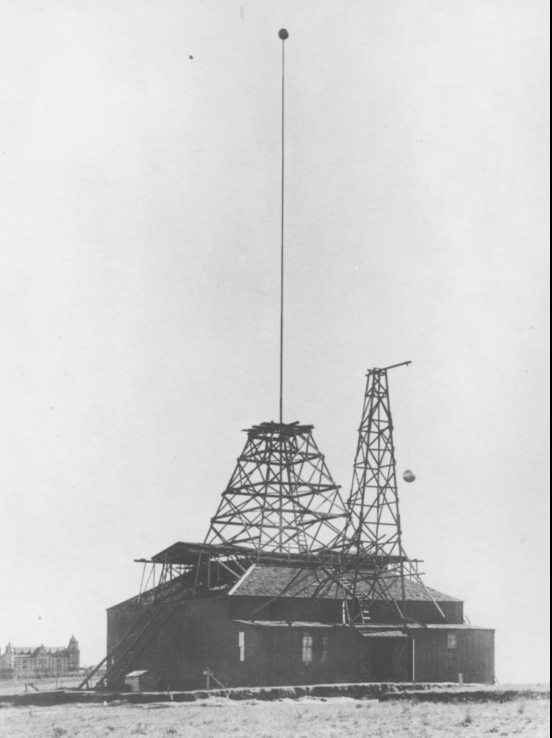A New Step: Larger Laboratory and Higher Voltages
After the encouraging results achieved in his new laboratory in New York, Tesla was ready for the next step. This required a larger facility to accommodate bigger transformers capable of generating voltages around 10 million volts.
With donations from investors and friends who believed Tesla was on the right path, he found a suitable plateau in Colorado, at an altitude of around 2,000 meters. This terrain was perfect for testing and refining Tesla’s ideas about long-distance wireless energy transmission. The conditions of rarefied air were particularly favourable, as lower pressure and density meant a lower dielectric strength, a lower ionization threshold, and better possibilities for electrical conduction.
Building the Colorado Springs Laboratory
A laboratory was built, with dimensions 15 by 18 meters. On top of the antenna connected to the secondary coil of Tesla’s transformer, there was a capacitive element in the form of a wooden ball covered with copper, 76 cm in diameter.
From the setup, it is clear that most of the research focused on perfecting the transmitter. Tesla experimented with various designs of his famous transformer, using additional coils, different types of wires, and varying winding methods for the primary and secondary coils.
Tesla’s High-Frequency Oscillations and Transformer Optimization
This renowned Tesla invention heavily relies on resonant phenomena, enabling the generation of high frequencies using either direct current impulses or low-frequency alternating currents. By applying spark gaps and capacitors that discharge rapidly, high-frequency oscillations were induced and maintained by injecting energy from a low-frequency source.
Tesla optimized the inductance and, particularly, the capacitance parameters to avoid overloading the transformer and generator while achieving maximum efficiency. Nevertheless, the high voltages and stresses occasionally led to equipment failures.
During his experiments, Tesla generated electric arcs and sparks longer than 30 feet.
Development of Sensitive Receivers
To study the phenomena observed in these experiments, Tesla also developed sensitive receivers capable of detecting high-frequency discharges.
These devices later laid the groundwork for future radio and other types of receivers.
Using them, during one stormy night, Tesla realized that standing waves were being formed. He concluded this based on measurements that remained possible even after the storm had moved over 200 miles away from his location.
Such results could only occur if standing waves were forming, allowing their effects to be detected even at distant locations where their amplitudes were significant.
Discovery of Earth Resonance and Energy Transmission Potential
This revelation gave Tesla the idea that wireless energy transmission over great distances could be achieved, practically limited only by the size of the planet. Losses would be just a few percent if Earth’s resonances were properly utilized.
By exciting the Earth through grounding, Tesla managed to achieve frequencies in the 10–12 Hz range—astonishingly close to what would later be recognized as the Schumann resonance (7.83 Hz), identified decades later.
He successfully transmitted energy over distances of tens of miles but realized that using only the Earth for transmission was impractical.
Thus, he began investigating mechanisms for transmitting energy through the atmosphere.
Atmospheric Conduction and Early Insight into the Ionosphere
Tesla concluded that there was a highly conductive layer in the atmosphere that could reflect electromagnetic waves.
Later research confirmed the existence of such a layer—the ionosphere—which indeed allows for the long-distance transmission of electromagnetic waves, overcoming Earth’s curvature.
Early Experiments in Modulating Signals
Tesla also developed techniques and practical solutions for modulating the excitation currents with voice or sound, laying the foundation for amplitude modulation (AM) used in wireless—radio—transmissions.
Legacy of the Colorado Springs Experiments
Although much more could be written to detail Tesla’s experiments in Colorado Springs, it is already clear that this period laid the foundations for radio broadcasting and Tesla’s never fully realized World System.
More on that in the continuation of this series at MilovanInnovation.
In the next post, we will explore Tesla’s work on electronic vacuum tubes.


Leave a Reply